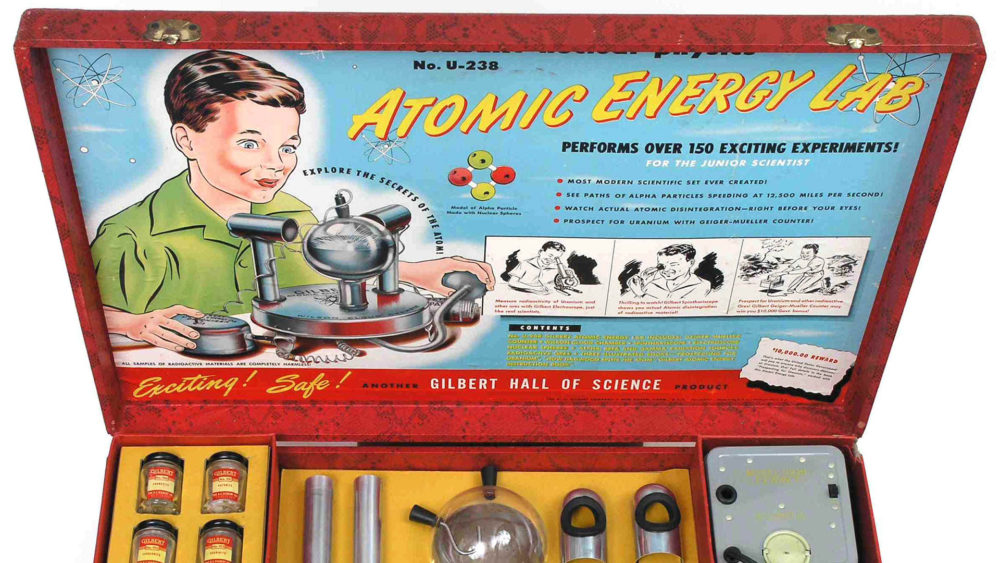
A.C. Gilbert Company, “U-238 Atomic Energy Lab” (1950-51), via Wikipedia.
Introduction
The Cold War was a global political and ideological struggle between capitalist and communist countries, led by the two surviving superpowers of the postwar world: the United States and the Union of Soviet Socialist Republics (USSR). “Cold” because it was never a “hot,” direct shooting war between the United States and the Soviet Union, the generations-long, multifaceted rivalry nevertheless bent the world to its whims. Tensions ran highest, perhaps, during the “first Cold War,” which lasted from the mid-1940s through the mid-1960s, after which followed a period of relaxed tensions and increased communication and cooperation, known by the French term détente, until the “second Cold War” interceded from roughly 1979 until the collapse of the Berlin Wall in 1989 and the dissolution of the Soviet Union in 1991. As the following sources reveal, the Cold War reshaped the world, and in so doing forever altered American life and the generations of Americans that lived within its shadow.
Documents
1. The Truman Doctrine (1947)
The “Truman Doctrine” directed the United States to actively support anti-communist forces around the world. The following is from President Truman’s March 12, 1947 address before a joint session of congress requesting support for anti-communist regimes in Greece and Turkey.
2. NSC-68 (1950)
In 1950, the National Security Council produced a 58-page, top-secret report proclaiming the threat of Soviet communism. In the new postwar world, the report argued, the United States could no longer retreat toward isolationism without encouraging the aggressive expansion of communism across the globe. The United States, the report said, had to mobilize to ensure the survival of “civilization itself.”
3. Joseph McCarthy on Communism (1950)
Senator Joseph McCarthy’s relentless attacks on suspected communist influence in American government so captivated American attention that “McCarthyism” came to stand in for the fervor of Cold War America’s anti-communism. In the following extract, McCarthy depicts what he imagined were the stakes his anti-communist crusades.
4. Dwight D. Eisenhower, “Atoms for Peace” (1953)
In 1953, President Dwight Eisenhower spoke to the United Nations’ General Assembly about the possibilities of peace in “the atomic age.”
5. Senator Margaret Chase Smith’s “Declaration of Conscience” (1950)
Senator Margaret Chase Smith of Maine condemned the tactics of Senator Joseph McCarthy in a congressional speech on June 1, 1950. She attacked McCarthy’s conspiratorial charges and broken lives left in their wake. She blamed political leaders of both parties for failing to corral McCarthy’s wild attacks.
6. Lillian Hellman Refuses to Name Names (1952)
The House Committee on Un-American Activities (HUAC) held hearings in 1947 on Communist activity in Hollywood. Many were called to testify and some, like playwright and screenwriter Lillian Hellman, refused to “name names”—to inform on others. Hellman invoked the Fifth Amendment protection against self-incrimination. Her decision landed her on the Hollywood “blacklist” and film companies refused to hire her. In the following letter to HUAC’s chairman, Hellman offered to testify as to her own activities if she would not be forced to inform on others.
7. Paul Robeson’s Appearance Before the House Un-American Activities Committee (1956)
Paul Robeson was a popular performer and African American political activist. He attacked racism and imperialism and advocated for African decolonization. He appeared before the House Un-American Activities Committee in 1956. He invoked the Fifth Amendment and refused to cooperate.
Media
Atomic Energy Lab 1951-1952

A.C. Gilbert Company, “U-238 Atomic Energy Lab” (1950-51), via Wikipedia.
This toy laboratory set was intended to let young people perform small scale experiments with radioactive materials in their own home. Equipped with a small working Geiger Counter, a “cloud chamber,” and samples of radioactive ore, the set’s creator claimed that the government supported its production to help Americans become more comfortable with nuclear energy.
Duck and Cover (1951)
In 1951, Archer Productions created “Duck and Cover,” a civil defense film funded by the U.S. Federal Civil Defense Administration. The short film, starring Bert the Turtle and shown to Cold War school children, demonstrates “duck and cover”–a physical position designed to mitigate the effects of a nuclear blast.